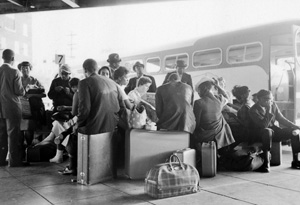Issues Facing America: The '60s

Photo: Getty Images
PAGE 9
Victory for Nonviolence
The Freedom Rides demonstrated the power of nonviolent direct action to achieve strategic victory. From its founding by pacifists in 1942, the Congress of Racial Equality (CORE) was committed to practicing methods of nonviolent direct action. The Rev. Jim Lawson, part of the second wave of Freedom Riders, had studied nonviolent philosophy and techniques in India and trained future leaders of the Nashville Student Movement.
The Freedom Riders were able to remain nonviolent even when their lives were in danger. Their courage and stoicism, even when beaten and bloodied, left a deep impression on the nation and the world. Nonviolence drew a stark contrast between the actions of the Freedom Riders and those of their segregationist foes, while at the same time bringing the injustice of racial oppression into the spotlight.
The success of the Freedom Rides showed that nonviolent direct action could do more than simply claim the moral high ground; in many situations, it could deliver better tactical results than either violent confrontation or gradual change through established legal mechanisms.
Fresh waves of Riders would arrive to take the places of those Riders who had already been injured and jailed. Movement leaders like Martin Luther King Jr. who initially considered the Freedom Rides too risky became outspoken supporters, paving the way for nonviolent actions like the Birmingham campaign of 1963 and the Selma to Montgomery marches for voting rights of 1965.
The Freedom Rides demonstrated the power of nonviolent direct action to achieve strategic victory. From its founding by pacifists in 1942, the Congress of Racial Equality (CORE) was committed to practicing methods of nonviolent direct action. The Rev. Jim Lawson, part of the second wave of Freedom Riders, had studied nonviolent philosophy and techniques in India and trained future leaders of the Nashville Student Movement.
The Freedom Riders were able to remain nonviolent even when their lives were in danger. Their courage and stoicism, even when beaten and bloodied, left a deep impression on the nation and the world. Nonviolence drew a stark contrast between the actions of the Freedom Riders and those of their segregationist foes, while at the same time bringing the injustice of racial oppression into the spotlight.
The success of the Freedom Rides showed that nonviolent direct action could do more than simply claim the moral high ground; in many situations, it could deliver better tactical results than either violent confrontation or gradual change through established legal mechanisms.
Fresh waves of Riders would arrive to take the places of those Riders who had already been injured and jailed. Movement leaders like Martin Luther King Jr. who initially considered the Freedom Rides too risky became outspoken supporters, paving the way for nonviolent actions like the Birmingham campaign of 1963 and the Selma to Montgomery marches for voting rights of 1965.
ONLINE CONTENT COURTESY OF
"FREEDOM RIDERS"
AMERICAN EXPERIENCE, A WGBH PRODUCTION FOR PBS
"FREEDOM RIDERS"
AMERICAN EXPERIENCE, A WGBH PRODUCTION FOR PBS



